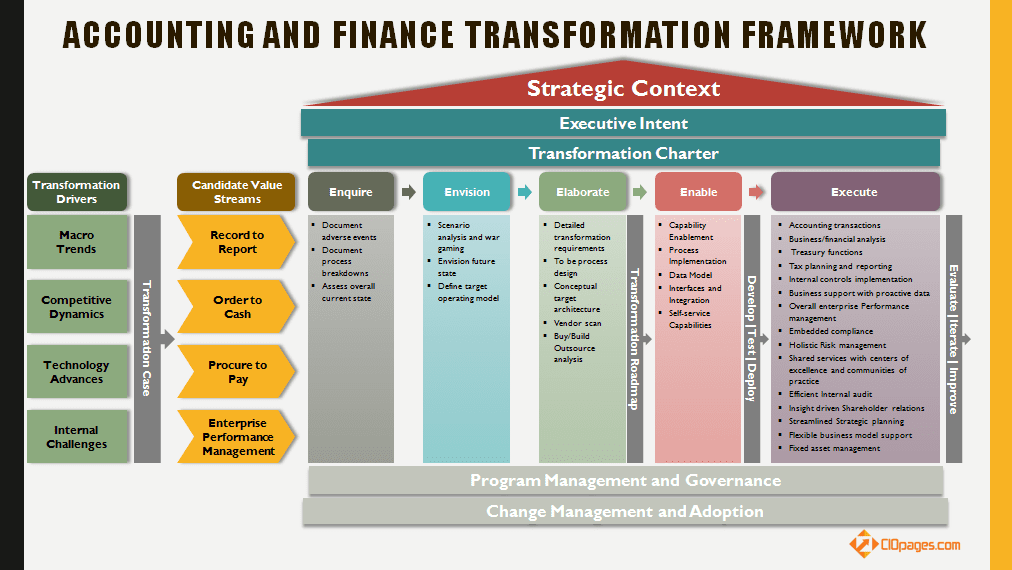Finance Transformation Framework
By: Ciopages Staff Writer
Updated on: Feb 25, 2023

CIOPages.com Accounting and Finance Transformation Framework is a simple and cohesive approach to planning and executing a fundamental shift in how finance and accounting work.
Before we dissect the components of the Accounting and Finance Transformation Framework briefly, please also note that CIOPages.com offers a Finance and Accounting Transformation Toolkit, and other finance and accounting transformation resources.
Transforming accounting and finance functions are a non-trivial task, particularly it involves transformation involving the operating model, the key value streams and processes, people and their roles.
CIOPages.com Accounting and Finance Transformation Framework Components:
Strategic Context:
CIOPages.com Accounting and Finance Transformation Framework starts with understanding the strategic context of the proposed transformation. This will involve understanding the business needs and corporate objectives, the future vision of the company and the expectations from accounting and finance functions.
Executive Intent:
Executive Intent details the goals, objectives and desired outcomes as well as the level of support for the accounting and finance transformation endeavor. You may want to create a stakeholder map to capture the degree of interest, influence, and intent of various stakeholders.
Transformation Charter:
The transformation charter is a concise but a coherent summary of what problems the firm is trying to solve for and the desired outcomes from the transformation endeavor. It is not a detailed business case or a project charter, but a higher-level document.
Transformation Drivers:
The next component of the accounting and finance transformation framework is identifying and documenting the factors that are necessitating the transformation. These transformation drivers include the following:
- Macro trends: These are global and national events shaping the economy, industry, and the society as a whole, which in turn will impact the company. These can range from demographics to social mores, globalization to environmental considerations, from geopolitical events to labor movement. A PESTLE analysis captures these factors.
- Competitive Dynamics: These factors are typical competitive analysis and should include not only the direct competitors, but indirect competitors, emerging non-traditional competitors who may upend the industry, and others. A competitive analysis framework such as Michael Porter’s Five Forces Model might be useful.
- Technology Advances: Thack Brown of SAP listed five technology factors which are influencing accounting and finance functions. Also, there may be others which may be impacting the finance and accounting value streams in your particular industry.
- Internal Challenges: The internal challenges are all the current state problems that the firm is facing in the accounting and finance operations. These items comprise of all the breakdowns, service recovery issues, process bottlenecks, data inaccuracies, delays, cumbersome processes et
Candidate Value Streams:
The candidate value streams address the scope and enormity of the transformation challenge by identifying end-to-end Accounting and Finance value streams of the company. It depends on how big of change your business is undertaking, but typically the value streams could be Record to Report, Data to Insight, Order to Cash, Procure to Pay, etc.
Transformation Steps:
CIOPages.com Accounting and Finance Transformation Framework outlines six steps in implementing a finance transformation program.
- Enquire – Understand the current state issues, challenges, and impediments.
- Envision – Paint a picture of the future without being encumbered by the current situation.
- Elaborate – Drill down into what needs to be done, how it needs to get done in greater detail.
- Enable –This is where the rubber hits the road as in actually implementing the changes envisaged in the transformation.
- Execute – This step involved operating the new generation finance and accounting operations included in and performed as a part of the accounting and finance transformation framework.
- Evaluate – This addresses the concept of measuring the key success factors and key performance indicators and using that learning to improve the finance and accounting function iteratively and incrementally post the finance and accounting transformation.
Program Management:
Needless to add no accounting and finance transformation framework is complete without program administration and governance. This includes the way the project is funded, the steering committees who are accountable, the governance structure, the PMO office, as well as projects and work streams. Should you need it, CIOPages.com offers a finance and accounting transformation project plan list.
Change Management and Adoption:
A Change management Plan is a critical consideration in any transformation endeavor. Hence including a robust change management and adoption plan will be extremely vital in making any major transformation program a success.
You can download the CIOPages.com Accounting and Finance Transformation Framework PowerPoint slide for free (after social sharing). And of course, you modify the power point for your own needs, as long as it contains the citation “Adapted from CIOPages.com Accounting and Finance Transformation Framework.”
-
Finance Capability Model
U.S. $699 – U.S. $1,999Category : Capability Models
View Product This product has multiple variants. The options may be chosen on the product page